英美文学选读(1)
- 格式:doc
- 大小:79.00 KB
- 文档页数:5

自学考试英美文学选读Selected Readings In English AndAmerican LiteraturesPart one: English literatureAn Introduction to Old and Medieval EnglishLiterature1. The Old English poetry that has survived can be dividedinto two group: the religious group and the secular one. The poetry of the religious group is mainly on biblical themes………In addition to these religious compositions, Old English poets produced the national epic poem, Beowulf, a typical example of Old English poetry, is regarded today as the national epic of the Anglo-Saxons.2. Romance which uses narrative verse or prose to singknightly adventures or other heroic deeds is a popular literary form in the medieval period. R omantic love is an important part of the plot in romance.3. I t is Chaucer alone who, for the first time in Englishliterature, presented to us a comprehensive realistic picture of the English society of his time and created a whole gallery of vivid characters from all walks of life in his masterpiece The Canterbury Tales.Geoffrey Chaucer is the greatest writer of this period.I n short, Chaucer develops his characterization to a higherartistic level by presenting characters with both typical qualities and individual dispositions. Chaucer introduced from France the rhymed stanzas of various types to English poetry to replace the Old English alliterative verse.Chaucer dominated the works of his15th-centtruy English followers and the so-called Scottish Chaucerians. For the Renaissance, he was the English Homer.Chapter 1 The Renaissance Period1. The Renaissance arks a transition from the medieval tothe modern world. Generally, it refers to the periodbetween the 14th and mid-17th centuries.T he Renaissance is a historical period in which the European humanist thinkers and scholars made attempts to get rid of those old feudalist ideas in medieval Europe, to introduce new ideas that expressed the interests of the rising bourgeoisie, and to recover the purity of the early church form the corruption of the Roman Catholic Church. B ut it was not until the reign of Henry VIII that the Renaissance really began to show its effect in England.The English Renaissance had no sharp break with the past.Attitudes and feelings which had been characteristic of the 14th and 15th centuries persisted well down into the era of Humanism and Reformation.2. Humanism is the essence of the Renaissance. T hus, byemphasizing the dignity of human beings and the importance of the present life, they voiced their beliefs that man did not only have the right to enjoy the beauty of this life, but had the ability to perfect himself and to perform wonders.3. S trong national feeling in the time of the Tudors gave agreat incentive to the cultural development in England. W ith classical culture and the Italian humanistic ideas coming into England, the English Renaissance began flourishing.T he first period of the English Renaissance was one of imitation and assimilation. T he Elizabethan drama, in its totality, is the real mainstream of the English Renaissance.4. F rom Wyatt and Surrey onwards the goals of humanisticpoetry are: skillful handling of conventions, force of language, and, above all, the development of a rhetorical plan in which meter, rhyme, scheme, imagery and argument should all be combined to frame the emotional theme and throw it into high relief. P oetry was to be a concentrated exercise of the mind, of craftsmanship, and of learning.I. Edmund Spenser (埃德蒙·斯宾塞)1. Spenser’s masterpiece is The Faerie Queene, a great poemof its age. A ccording to Spenser’s own explanation, his principal intention is to present through a “historical poem”the example of a perfect gentleman: “to fashion a gentleman or noble person in virtuous and gentle discipline.”2. The five main qualities of Spenser’s poetry are 1) aperfect melody; 2) a rare sense of beauty; 3) a splendid imagination; 4) a lofty moral purity and seriousness; and 5)a dedicated idealism.II. Christopher Marlowe(克里斯托夫·马洛)1. M asterpieces: Tamburlaine, Parts I ⅈ Dr. Faustus;The Jew of Malta; Edward II2. Tamburlaine is a play about an ambitious and pitilessTartar conqueror in the fourteenth century who rose from a shepherd to an overpowering king. I n fact, Tamburlaine is a product of Marlowe’s characteristically Renaissance imagination, fascinated by the earthly magnificence available to men of imaginative power who have the energy of their convictions.3. D r. Faustus is a play based on the German legend of amagician aspiring for knowledge and finally meeting his tragic end as a result of selling his soul to the Devil. I t celebrates the human passion for knowledge, power and happiness; it also reveals man’s frustration in realizing the high aspirations in a hostile moral order. A nd the confinement to time is the cruelest fact of man’s condition.Marlowe praises his soaring aspiration for knowledge while warning against the sin of pride since Faustus’s downfall was caused by his despair I god and trust in Devil.4. M arlowe’s greatest achievement lies in that he perfectedthe blank verse and made it the principal medium of English drama. Marlowe employed hyperbole as his major figure of speech, which, instead of referring to the exaggeration of the language, indicates the poetic energy and intensityconveyed through the verseMarlowe’s second achievement is his creation of the Renaissance hero for English drama. D ifferent from the tragic hero I medieval plays, who seeks the way to heaven through salvation and God’s will, he is against convention al morality and contrives to obtain heaven on earth through his own efforts.III. William Shakespeare (威廉·莎士比亚)1. T he first period of Shakespeare’s dramatic career was oneof apprenticeship.(Henry VI; Richard III; The Comedy of Errors.In the second period, Shakespeare’s style and approach became highly individualized. B y constructing a complex pattern between different characters and between appearance and reality, Shakespeare made subtle comments on a variety of human foibles. (The M idsummer Night’s Dream; The Merchant of Venice; Romeo and Juliet.S hakespeare’s third period includes his greatest tragedies and his so-called dark comedies. (Hamlet; Othello;King Lear)T he last period of Shakespeare’s work includes his principal romantic tragicomedies.2. S hakespeare’s history plays are mainly written under theprinciple that national unity under a mighty and just sovereign is a necessity.3. I n his romantic comedies, Shakespeare takes an optimisticattitude toward love and youth, and the romantic elements are brought into full play. T he most important play among the comedies is The Merchant of Venice. T he sophistication derives in part from the play between high, outgoing romance and dark forces of negativity and hate. T he traditional theme of this play is to praise the friendship between Antonio and Bassanio, to idealize Portia as a heroine of great beauty, wit and loyalty, and to expose the insatiable greed and brutality of the Jew.C ompared with the idealism of other plays, The Merchantof Venice takes a step forward in its realistic presentation of human nature and human conflict. T hough there is a ridiculous touch on the part of the characters restrained by their limitations, Shakespeare’s youthful Renaissance spirit of jollity can be fully seen in contrast to the medieval emphasis on future life in the next world.4. T he successful romantic tragedy is Romeo and Juliet,which eulogizes the faithfulness of love and the spirit of pursuing happiness. T he play, though a tragedy, is permeated with optimistic spirit.5. S hakespeare’s greatest tragedies are: Hamlet, Othello,King Lear, and Macbeth. T hey have some characteristics in common. Each portrays some noble hero, who faces the injustice of human life and is caught in a difficult situation and whose fate is closely connected with the fate of the whole action. E ach hero has his weakness of nature.W ith the concentration on the tragic hero, we see the sharp conflicts between the individual and the evil force in the society, which shows that Shakespeare is a great realist in the true sense.6. T he hero Hamlet in Shakespeare’s play Hamlet is noted forhis hesitation to take his revenge, his melancholy nature of action only to deny possibilities to do anything. H e came to know that his father was murdered by his uncle who became king. He hated him so deeply that he wanted to kill him.B ut he loved his widowed mother who later married hisuncle, and he was afraid to hurt his mother. A nd also, when everything was ready for him to kill his uncle, he forgave him for his uncle was praying to God for his crime. T hus he lost the good chance. H amlet represented humanism of his time.7. S hakespeare takes the bare outlines of Revenge Tragedy,but what he adds is infinitely more interesting than what he adopts. A nd the timeless appeal of this mighty drama lies in its combination of intrigue, emotional conflict andsearching philosophic melancholy. T his play is also Shakespeare’s most detailed expose of a corrupted court—“an unweeded garden”in which there is nothing but“a foul and pestilent congregation of vapours.”B y revealing the power-seeking ,the jostling for place the hidden motives, the courteous superficialities that veil lust and guilt, Shakespeare condemns the hypocrisy and treachery and general corruption at the royal court.8. Shakespeare, as a humanist of the time, is againstreligious persecution and racial discrimination, against social inequality and the corrupting influence of gold and money. I n his plays, he does not hesitate to describe the cruelty and anti-natural character of the civil wars, but he did not go all the way against the feudal rule.9. S hakespeare’s views on literature:Shakespeare has accepted the Renaissance views on literature. H e holds that literature should be a combination of beauty, kindness and truth, and should reflect nature and reality. Shakespeare also states that literary works which have truly reflected nature and reality can reach immortality.10. T he characteristics of Shakespeare’s characters:S hakespeare’s major characters are neither merely individual ones nor type ones; they are individuals representing certain types. E ach character has his or her own personalities; meanwhile, they may share features with others.11. T he characteristics of Shakespeare’s plot:S hakespeare’s plays are well-known for their adroit plot construction. S hakespeare seldom invents his own plots;instead, he borrows them from some old plays or storybooks, or from ancient Greek and Roman sources.12. T he characteristics of Shakespeare’s language:I t is necessary to study the subtlest of his instruments—the language. Shakespeare can write skillfully in different poetic form, like the sonnet, the blank verse, and therhymed couplet. H e has an amazing wealth of vocabulary and idiom. H is coinage of new words and distortion of the meaning of the old ones also create striking effects on the reader.IV. Francis Bacon (弗兰西斯·培根)1. Francis Bacon, a representative of the Renaissance inEngland, is a well-known philosopher, scientist and essayist.2. T he most important works of his first group include TheAdvancement of Learning; Novum Organum. H is philosophical works also belong to the first group. H is literary works are in the second group, among which the most famous is Essays. Maxis of Law and The Learned Reading upon the Statute of Uses are the two famous works from the third group.3. N ovum Organum is a successful treatise written in Latin onmethodology. I t is the most impressive display of bacon’s intellect. T he argument is for the use of inductive method of reasoning in scientific study. B ut Bacon first expounds the four great false conceiving that beset men’s mind and prevent them from seeking the truth. B acon suggests the inductive reasoning, i.e. proceeding from the particular to the general, the deductive reasoning, putting forward this theory. B acon shows the new empirical attitudes toward truth about nature and bravely challenges the medieval scholasticists.4. T he Advancement of Learning is a great tract oneducation. B acon highly praises knowledge, refuting the objections to learning and outlining the problems with which his plan is to deal. A ccording to Bacon, man’s understanding consists of three parts: history to man’s memory, poetry to man’s imagination and creation, and philosophy to man’s reason.5. B acon cares more about axioms under the guidance of whichman think and acts than human nature or morality.B acon’s essays are famous for their brevity, compactnessand powerfulness. T he essays are well-arranged and enriched by Biblical allusions, metaphors and cadence.6. O f Studies is the most popular of Bacon’s 58 essays. I tanalyzes what studies chiefly serve for, the different ways adopted by different people to pursue studies, and how studies exert influence over human character. F orceful and persuasive, compact and precise. O f Studies reveals to us Bacon’s mature attitude towards learning.V. J ohn Donne (约翰·邓恩)1. T he term “metaphysical poetry”is commonly used to namethe work of the 17th-century writers who wrote under the influence of John Donne. W ith a rebellious spirit the metaphysical poets tried to break away from the conventional fashion of the Elizabethan love poetry. T he diction is simple as compared with that of the Elizabethan or the Neoclassic periods, and echoes the words and cadences of common speech.T he imagery is drawn from the actual life. T he form is frequently that of an argument with the poet’s beloved, with God, or with himself.2. T he Elegies and Satires; The Songs and Sonnets.VI. J ohn Milton (约翰·弥尔顿)1. Paradise Lost ; Paradise Regained; Samson Agonistes.2. P aradise Lost is about Eve, seduced by Satan’s rhetoricand her own confused ambition—as well as the mere prompting of hunger—falls into sin through innocent credulity. A dam falls by consciously choosing human love rather than obeying God.T his is the error wherein his greatness lies. I n the fall of man Adam discovered his full humanity. B ut man’s fall is the sequel to another and more stupendous tragedy.3. W orking through the tradition of a Christian humanism,Milton wrote Paradise Lost, intending to expose the ways of Satan and to “justify the ways of God to men.”A t the center of the conflict between human love and spiritual duty liesMilton’s fundamental concern with freedom and choice; the freedom to submit to God’s prohibition on eating the apple and the choice of disobedience made for love.4. T he freedom of the will is the keystone of Milton’screed. H is poem attempts to convince us that the unquestionable truth of Biblical revelation means that an all-knowing God was just in allowing Adam and Eve to be tempted and, of their free will, to choose sin and its inevitable punishment. A nd, thereby, it opens the way for the voluntary sacrifice of Christ which showed the mercy of God in bringing good out of evil.5. I n his life, Milton shows himself a real revolutionary, amaster poet and a great prose writer. H e fought for freedom in all aspects as a Christian humanist, while his achievements in literature make him tower over all the other English writers of his time and exert a great influence over later ones.莎士比亚1. 莎士比亚戏剧生涯的第一阶段是作为一名学徒。
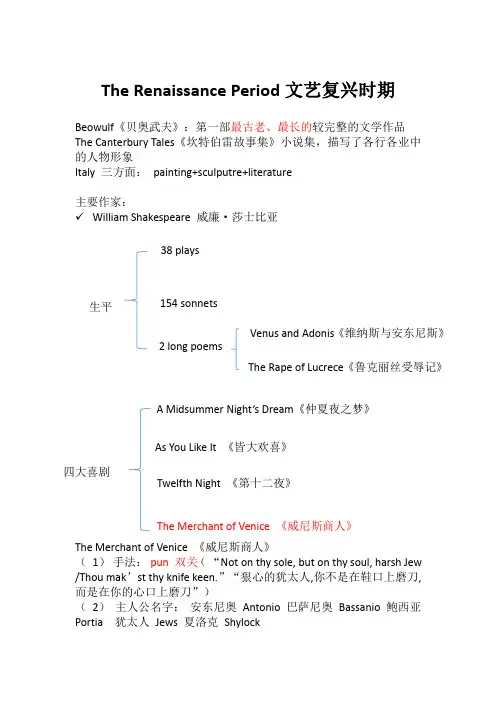
The Renaissance Period 文艺复兴时期Beowulf 《贝奥武夫》:第一部最古老、最长的较完整的文学作品The Canterbury Tales 《坎特伯雷故事集》小说集,描写了各行各业中的人物形象Italy 三方面:painting+sculputre+literature主要作家:William Shakespeare 威廉·莎士比亚The Merchant of Venice 《威尼斯商人》(1)手法:pun 双关(“Not on thy sole,but on thy soul,harsh Jew /Thou mak ’st thy knife keen.”“狠心的犹太人,你不是在鞋口上磨刀,而是在你的心口上磨刀”)(2)主人公名字:安东尼奥Antonio 巴萨尼奥Bassanio 鲍西亚Portia 犹太人Jews 夏洛克Shylock 生平2long poems 154sonnets38playsVenus and Adonis 《维纳斯与安东尼斯》The Rape of Lucrece 《鲁克丽丝受辱记》四大喜剧A Midsummer Night’s Dream 《仲夏夜之梦》As You Like It 《皆大欢喜》Twelfth Night 《第十二夜》The Merchant of Venice 《威尼斯商人》Hamlet 《哈姆雷特》(1)手法:soliloquy 独白(“To be,or not to be —that is the question ”)(2)The first and the most popular play of Shakespeare十四行诗(18)(1)起源Italy引入英国的人Wyatt 华埃特(2)经典名句:“Shall I compare thee to a summer ’s day?”我可能把你和夏天相比拟?(3)修辞:Personification 拟人手法(4)主题:美好夏日通常短暂,但诗歌之美却能永存。

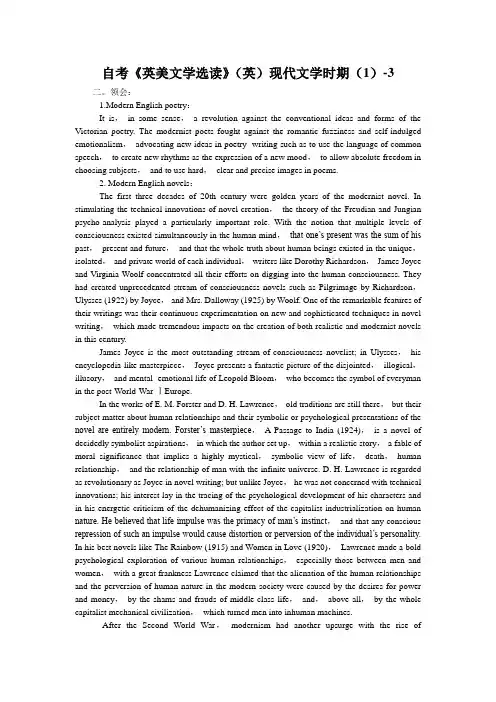
自考《英美文学选读》(英)现代文学时期(1)-3二。
领会:1.Modern English poetry:It is,in some sense,a revolution against the conventional ideas and forms of the Victorian poetry. The modernist poets fought against the romantic fuzziness and self-indulged emotionalism,advocating new ideas in poetry- writing such as to use the language of common speech,to create new rhythms as the expression of a new mood,to allow absolute freedom in choosing subjects,and to use hard,clear and precise images in poems.2. Modern English novels:The first three decades of 20th century were golden years of the modernist novel. In stimulating the technical innovations of novel creation,the theory of the Freudian and Jungian psycho-analysis played a particularly important role. With the notion that multiple levels of consciousness existed simultaneously in the human mind,that one’s present was the sum of his past,present and future,and that the whole truth about human beings existed in the unique,isolated,and private world of each individual,writers like Dorothy Richardson,James Joyce and Virginia Woolf concentrated all their efforts on digging into the human consciousness. They had created unprecedented stream-of-consciousness novels such as Pilgrimage by Richardson,Ulysses (1922) by Joyce,and Mrs. Dalloway (1925) by Woolf. One of the remarkable features of their writings was their continuous experimentation on new and sophisticated techniques in novel writing,which made tremendous impacts on the creation of both realistic and modernist novels in this century.James Joyce is the most outstanding stream-of-consciousness novelist; in Ulysses,his encyclopedia-like masterpiece,Joyce presents a fantastic picture of the disjointed,illogical,illusory,and mental- emotional life of Leopold Bloom,who becomes the symbol of everyman in the post-World-War-ⅠEurope.In the works of E. M. Forster and D. H. Lawrence,old traditions are still there,but their subject matter about human relationships and their symbolic or psychological presentations of the novel are entirely modern. Forster’s masterpiece,A Passage to India (1924),is a novel of decidedly symbolist aspirations,in which the author set up,within a realistic story,a fable of moral significance that implies a highly mystical,symbolic view of life,death,human relationship,and the relationship of man with the infinite universe. D. H. Lawrence is regarded as revolutionary as Joyce in novel writing; but unlike Joyce,he was not concerned with technical innovations; his interest lay in the tracing of the psychological development of his characters and in his energetic criticism of the dehumanizing effect of the capitalist industrialization on human nature. He believed that life impulse was the primacy of man’s instinct,and that any conscious repression of such an impulse would cause distortion or perversion of the individual’s personality. In his best novels like The Rainbow (1915) and Women in Love (1920),Lawrence made a bold psychological exploration of various human relationships,especially those between men and women,with a great frankness Lawrence claimed that the alienation of the human relationships and the perversion of human nature in the modern society were caused by the desires for power and money,by the shams and frauds of middle-class life,and,above all,by the whole capitalist mechanical civilization,which turned men into inhuman machines.After the Second World War,modernism had another upsurge with the rise ofexistentialism which was reflected mainly in drama.[Nextpage]3. The development of 20th century English drama:The most celebrated dramatists in the last decade of the 19th century were Oscar Wilde and George Bernard Shaw,who,in a sense,pioneered the modern drama,though they did not make so many innovations in techniques and forms as modernist poets or novelists. Wilde expressed a satirical and bitter attitude towards the upper-class people by revealing their corruption,their snobbery,and their hypocrisy in his plays,especially in his masterpiece,The Importance-of Being Earnest (1895)。
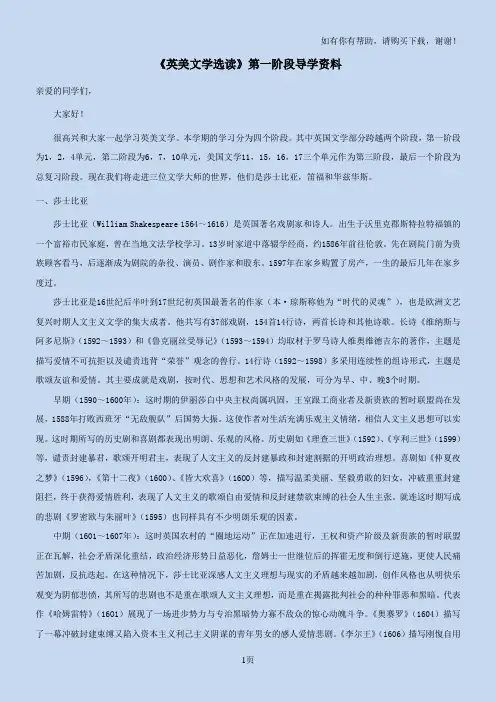
《英美文学选读》第一阶段导学资料亲爱的同学们,大家好!很高兴和大家一起学习英美文学。
本学期的学习分为四个阶段。
其中英国文学部分跨越两个阶段,第一阶段为1,2,4单元,第二阶段为6,7,10单元,美国文学11,15,16,17三个单元作为第三阶段,最后一个阶段为总复习阶段。
现在我们将走进三位文学大师的世界,他们是莎士比亚,笛福和华兹华斯。
一、莎士比亚莎士比亚(William Shakespeare 1564~1616)是英国著名戏剧家和诗人。
出生于沃里克郡斯特拉特福镇的一个富裕市民家庭,曾在当地文法学校学习。
13岁时家道中落辍学经商,约1586年前往伦敦。
先在剧院门前为贵族顾客看马,后逐渐成为剧院的杂役、演员、剧作家和股东。
1597年在家乡购置了房产,一生的最后几年在家乡度过。
莎士比亚是16世纪后半叶到17世纪初英国最著名的作家(本·琼斯称他为“时代的灵魂”),也是欧洲文艺复兴时期人文主义文学的集大成者。
他共写有37部戏剧,154首14行诗,两首长诗和其他诗歌。
长诗《维纳斯与阿多尼斯》(1592~1593)和《鲁克丽丝受辱记》(1593~1594)均取材于罗马诗人维奥维德吉尔的著作,主题是描写爱情不可抗拒以及谴责违背“荣誉”观念的兽行。
14行诗(1592~1598)多采用连续性的组诗形式,主题是歌颂友谊和爱情。
其主要成就是戏剧,按时代、思想和艺术风格的发展,可分为早、中、晚3个时期。
早期(1590~1600年):这时期的伊丽莎白中央主权尚属巩固,王室跟工商业者及新贵族的暂时联盟尚在发展,1588年打败西班牙“无敌舰队”后国势大振。
这使作者对生活充满乐观主义情绪,相信人文主义思想可以实现。
这时期所写的历史剧和喜剧都表现出明朗、乐观的风格。
历史剧如《理查三世》(1592)、《亨利三世》(1599)等,谴责封建暴君,歌颂开明君主,表现了人文主义的反封建暴政和封建割据的开明政治理想。
喜剧如《仲夏夜之梦》(1596),《第十二夜》(1600)、《皆大欢喜》(16O0)等,描写温柔美丽、坚毅勇敢的妇女,冲破重重封建阻拦,终于获得爱情胜利,表现了人文主义的歌颂自由爱情和反封建禁欲束缚的社会人生主张。
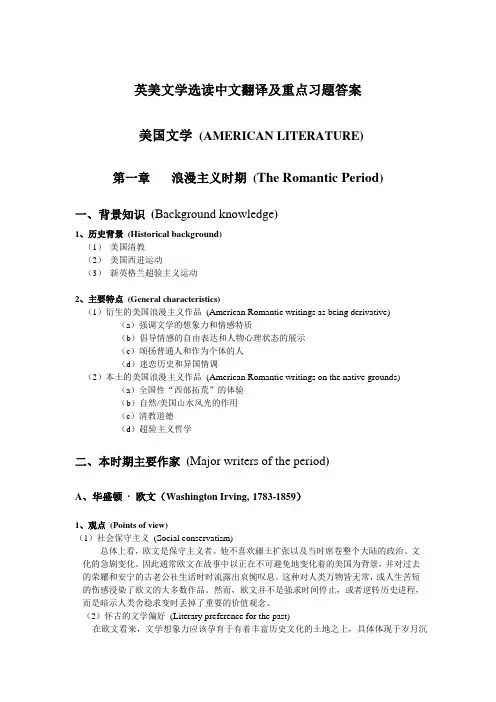
英美文学选读中文翻译及重点习题答案美国文学(AMERICAN LITERATURE)第一章浪漫主义时期(The Romantic Period)一、背景知识(Background knowledge)1、历史背景(Historical background)(1)美国清教(2)美国西进运动(3)新英格兰超验主义运动2、主要特点(General characteristics)(1)衍生的美国浪漫主义作品(American Romantic writings as being derivative) (a)强调文学的想象力和情感特质(b)倡导情感的自由表达和人物心理状态的展示(c)颂扬普通人和作为个体的人(d)迷恋历史和异国情调(2)本土的美国浪漫主义作品(American Romantic writings on the native grounds) (a)全国性“西部拓荒”的体验(b)自然/美国山水风光的作用(c)清教道德(d)超验主义哲学二、本时期主要作家(Major writers of the period)A、华盛顿·欧文(Washington Irving,1783-1859)1、观点(Points of view)(1)社会保守主义(Social conservatism)总体上看,欧文是保守主义者。
他不喜欢疆土扩张以及当时席卷整个大陆的政治、文化的急剧变化。
因此通常欧文在故事中以正在不可避免地变化着的美国为背景,并对过去的荣耀和安宁的古老公社生活时时流露出哀惋叹息。
这种对人类万物皆无常,或人生苦短的伤感浸染了欧文的大多数作品。
然而,欧文并不是强求时间停止,或者逆转历史进程,而是暗示人类舍稳求变时丢掉了重要的价值观念。
(2)怀古的文学偏好(Literary preference for the past)在欧文看来,文学想象力应该孕育于有着丰富历史文化的土地之上,具体体现于岁月沉积而成的珍宝中,如破败的城堡、坍塌的塔楼、艺术的珍品、高度文明社会的精妙物件以及远古和当地风俗的古怪意趣。

《英美文学选读》课程教学大纲(2005年制订,2006年修订)课程编号:100187英文名:Selected Readings in British and American Literature课程类别:专业主干课前置课: 英美文学导论学分:3学分课时:54课时主讲教师:冯建文选定教材:王守仁,《英国文学选读》,高等教育出版社,2001年。
陶洁,《美国文学选读》,高等教育出版社,2001年。
课程概述:《英美文学选读》课程的教学内容是根据本课程的性质、学习目的以及英语专业高年级教学的特点确定的。
本课程主要内容包括英国和美国文学史上代表作家的简要介绍和作品选读。
结合英国和美国文学各个历史断代的主要历史背景,文学文化思潮和流派,社会政治、经济、文化等对英国和美国文学史上最具有影响、最具有代表性的作家的作品中的艺术特色、主题结构、人物刻画、语言风格和思想意义等进行深入地分析。
教学目的:《英美文学选读》是英语语言文学专业本科四年级学生的选修课程,是为培养理解和鉴赏英国和美国文学原著的能力而设置的一门专业理论课程。
设置本课程旨在使学生在掌握英国和美国文学源流和发展的基础之上,通过阅读具有代表性的英国和美国文学作品,理解作品的内容,学会分析作品的艺术特色并努力掌握正确评价文学作品的标准和方法,增强对作品中表现的社会生活和人物感情的理解,提高语言基本功和阅读文学作品的能力和鉴赏水平。
教学方法:课堂讲授和研讨相结合,教师布置学生课前对作家生平和历史背景进行研究,并向学生提供参考书目和相关网站;课堂上进行重点阅读和分析;组织课堂讨论,鼓励新视角和新思维;并通过影视、多媒体等手段辅助教学,在期中和期末布置学期论文和考查来检验教学效果。
各章教学要求及教学要点(加星号*为重点内容)英国文学部分第一章:Early And Medieval English Literature教学要求:细读英国伟大诗人乔叟的代表作品《坎特伯雷故事集》的节选,分析其主要语言和叙事特色,解读作品中反映出的中世纪的宗教、政治、经济和市民生活等诸多方面的问题。
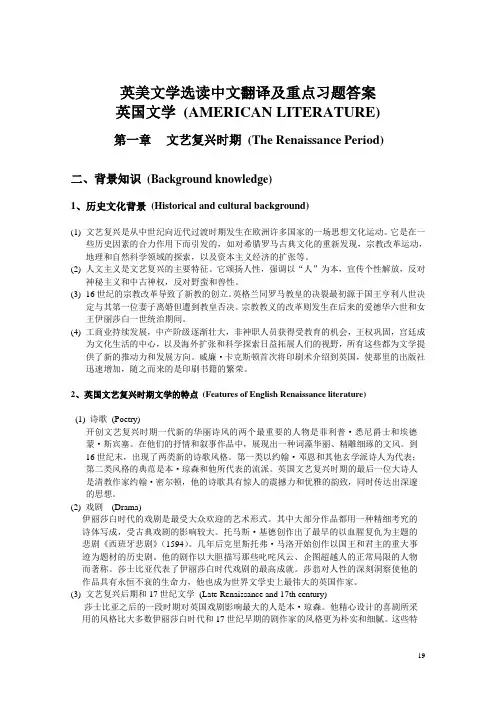
英美文学选读中文翻译及重点习题答案英国文学(AMERICAN LITERATURE)第一章文艺复兴时期(The Renaissance Period)二、背景知识(Background knowledge)1、历史文化背景(Historical and cultural background)(1)文艺复兴是从中世纪向近代过渡时期发生在欧洲许多国家的一场思想文化运动。
它是在一些历史因素的合力作用下而引发的,如对希腊罗马古典文化的重新发现,宗教改革运动,地理和自然科学领域的探索,以及资本主义经济的扩张等。
(2)人文主义是文艺复兴的主要特征。
它颂扬人性,强调以“人”为本,宣传个性解放,反对神秘主义和中古神权,反对野蛮和兽性。
(3)16世纪的宗教改革导致了新教的创立。
英格兰同罗马教皇的决裂最初源于国王亨利八世决定与其第一位妻子离婚但遭到教皇否决。
宗教教义的改革则发生在后来的爱德华六世和女王伊丽莎白一世统治期间。
(4)工商业持续发展,中产阶级逐渐壮大,非神职人员获得受教育的机会,王权巩固,宫廷成为文化生活的中心,以及海外扩张和科学探索日益拓展人们的视野,所有这些都为文学提供了新的推动力和发展方向。
威廉·卡克斯顿首次将印刷术介绍到英国,使那里的出版社迅速增加,随之而来的是印刷书籍的繁荣。
2、英国文艺复兴时期文学的特点(Features of English Renaissance literature)(1) 诗歌(Poetry)开创文艺复兴时期一代新的华丽诗风的两个最重要的人物是菲利普·悉尼爵士和埃德蒙·斯宾塞。
在他们的抒情和叙事作品中,展现出一种词藻华丽、精雕细琢的文风。
到16世纪末,出现了两类新的诗歌风格。
第一类以约翰·邓恩和其他玄学派诗人为代表;第二类风格的典范是本·琼森和他所代表的流派。
英国文艺复兴时期的最后一位大诗人是清教作家约翰·密尔顿,他的诗歌具有惊人的震撼力和优雅的韵致,同时传达出深邃的思想。
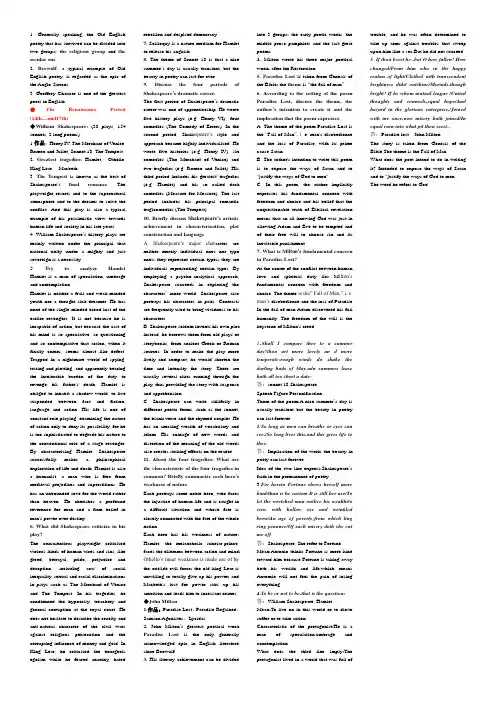
1. Generally speaking, the Old English poetry that has survived can be divided into two groups: the religious group and the secular one.2. Beowulf, a typical example of Old English poetry, is regarded as the epic of the Anglo-Saxons.3. Geoffrey Chaucer is one of the greatest poets in English.●The Renaissance Period (14th---mid17th)◆William Shakespeare: (38 plays, 154 sonnets, 2 long poems)1.作品:Henry IV, The Merchant of Venice, Romeo and Juliet, Sonnet 18, The Tempest2. Greatest tragedies:Hamlet, Othello, King Lear, Macbeth.3. The Tempest is known as the best of Shakespeare’s final romance. The playwright resorts and to the supernatural atmosphere and to the dreams to solve the conflict. And this play is also a typical example of his pessimistic view towards human life and society in his late years.4. William Shakespeare’s history plays are mainly written under the principal that national unity under a mighty and just sovereign is a necessity.5.Try to analyze Hamlet Hamlet is a man of speculation, umbrage and contemplation.Hamlet is neither a frail and weak minded youth nor a thought sick dreamer. He has none of the single minded blood lust of the earlier revengers. It is not because he is incapable of action, but because the cast of his mind is so speculative, so questioning and so contemplative that action, when it finally comes, seems almost like defeat. Trapped in a nightmare world of spying, testing and plotting, and apparently bearing the intolerable burden of the duty to revenge his father's death, Hamlet is obliged to inhabit a shadow world, to live suspended between fact and fiction, language and action. His life is one of constant role playing, examining the nature of action only to deny its possibility, for he is too sophisticated to degrade his nature to the conventional role of a stage revenger. By characterizing Hamlet, Shakespeare successfully makes a philosophical exploration of life and death. Hamlet is also a humanist, a man who is free from medieval prejudices and superstitions. He has an unbounded love for the world rather than heaven. He cherishes a profound reverence for man and a firm belief in man's power over destiny.6. What did Shakespeare criticize in his play?The conscientious playwright criticized various kinds of human vices and sins, like greed, betrayal, pride, prejudice and deception, including acts of social inequality, sexual and racial discriminations in plays such as The Merchant of Venice and The Tempest. In his tragedies, he condemned the hypocrisy, treachery and general corruption at the royal court. He does not hesitate to describe the cruelty and anti-natural character of the civil wars against religious persecution and the corrupting influence of money and gold. In King Lear, he criticized the bourgeois egoism while he feared anarchy, hated rebellion and despised democracy.7. Soliloquy is a nature medium for Hamletto release his anguish.8.The theme of Sonnet 18 is that a nicesummer’s day is usually transient, but thebeauty in poetry can last for ever.9.Discuss the four periods ofShakespeare’s dramatic career.The first period of Shakespeare’s dramaticcareer was one of apprenticeship. He wrotefive history plays (e.g. Henry VI), fourcomedies (The Comedy of Errors). In thesecond period, Shak espeare’s style andapproach became highly individualized. Hewrote five histories (e.g. Henry IV), sixcomedies (The Merchant of Venice) andtwo tragedies (e.g. Romeo and Juliet). Histhird period includes his greatest' tragedies(e.g. Hamlet) and his so called darkcomedies (Measure for Measure). The lastperiod includes his principal romantictragicomedies (The Tempest).10. Briefly discuss Shakespeare’s artisticachievement in characterization, plotconstruction and languageA. Shakespeare’s major char acters areneither merely individual ones nor typeones; they represent certain types; they areindividuals representing certain types. Byemploying a psycho-analytical approach,Shakespeare succeeds in exploring thecharacters’inner world. Shakespeare alsoportrays his characters in pairs. Contrastsare frequently used to bring vividness to hischaracters.B. Shakespeare seldom invents his own plot;instead, he borrows them form old plays orstorybooks, from ancient Greek or Romansources. In order to make the play morelively and compact, he would shorten thetime and intensity the story. There areusually several clues running through theplay, thus providing the story with suspenseand apprehension.C. Shakespeare can write skillfully indifferent poetic forms, such as the sonnet,the blank verse and the rhymed couplet. Hehas an amazing wealth of vocabulary andidiom. His coinage of new words anddistortion of the meaning of the old wordsalso creates striking effects on the reader.11. About the four tragedies: What arethe characteristic of the four tragedies incommon? Briefly summarize each hero’sweakness of natureEach portrays some noble hero, who facesthe injustice of human life and is caught ina difficult situation and whose fate isclosely connected with the fate of the wholenation.Each hero has his weakness of nature:Hamlet, the melancholic scholar-prince,faces the dilemma between action and mind;Othello’s inner weakness is made use of bythe outside evil force; the old king Lear isunwilling to totally give up his power; andMacbeth's lust for power stirs up hisambition and leads him to incessant crimes.◆John Milton1.作品:Paradise Lost,Paradise Regained,Samson Agonistes,Lycidas2.John Milton’s greatest poetical workParadise Lost is the only generallyacknowledged epic in English literaturesince Beowulf3.His literary achievement can be dividedinto 3 groups: the early poetic works, themiddle prose pamphlets and the last greatpoems.4. Milton wrote his three major poeticalworks after the Restoration.5. Paradise Lost is taken from Genesis ofthe Bible; the theme is “the fall of man”6. According to the setting of the poemParadise Lost, discuss the theme, theauthor’s intention to create it and theimplication that the poem expresses.A. The theme of the poem Paradise Lost isthe "Fall of Man”, i. e. man's disobedienceand the loss of Paradise, with its primecause-Satan.B. The author's intention to write this poemis to expose the ways of Satan and to"justify the ways of God to men".C. In this poem, the author implicitlyexpresses his fundamental concern withfreedom and choice and his belief that theunquestionable truth of Biblical revelationmeans that an all knowing God was just inallowing Adam and Eve to be tempted andof their free will to choose sin and itsinevitable punishment.7. What is M ilton’s fundamental concernin Paradise Lost?At the center of the conflict between humanlove and spiritual duty lies M ilton’sfundamental concern with freedom andchoice. The theme is the” Fall of Man,” i. e.man’s disobedience and the loss of Paradise.In the fall of man Adam discovered his fullhumanity. The freedom of the will is thekeystone of Milton's creed.1.Shall I compare thee to a summerday?thou art more lovely an d moretemperate:rough winds do shake thedarling buds of May.adn summers leasehath all too short a date:答:sonnet 18,ShakespeareSpeech Figure PersonificationThem of the poem:A nice summer’s day isusually transient but the beauty in poetrycan last forever.2.So long as men can breathe or eyes cansee,/So long lives this,and this gives life tothee.答:Implication of the work: the beauty inpoety can last forever,Idea of the two line express:Shakespeare’sfaith in the permanence of poetry.3.For herein Fortune shows herself morekind/than is he custom.It is still her use/Tolet the wretched man outlive his wealth/toview with hollow eye and wrinkledbrow/An age of poverty:from which lingring penance/Of such misery doth she cutme off.答:Shakespeare, She refer to Fortune.Mean:Antonio thinks Fortune is more kindtoward him because Fortune is taking awayboth his wealth and life,which meansAntomio will not feel the pain of losingeverything.4.To be or not to be-that is the question:答:William Shakespeare, Hamlet.Mean:To live on in this world or to die:tosuffer or to take action.Characteristic of the protagonist:He is aman of speculation,umbrage andcontemplationWhat does the third line imply:Theprotagonist lived in a world that was full oftrouble, and he was often determined totake up arms against troubles that sweepupon him like a sea,But he did not succeed.5. If thou beest he -but O how fallen! Howchanged/From him who in the happyrealms of light/Clothed with transcendentbrightness didst outshine/Myriads,thoughbright! If he whom mutual league /Unitedthoughts and counsels,equal hope/Andhazard in the glorious enterprise,/Joinedwith me once,now misery hath joined/Inequal ruin:into what pit thou seest...答:Paradise lost John MiltonThe story is taken from Genesis of theBible,The theme is the Fall of Man.What does the poet intend to do in writingit? Intended to expose the ways of Satanand to “justify the ways of God to men.The word he refers to God.。
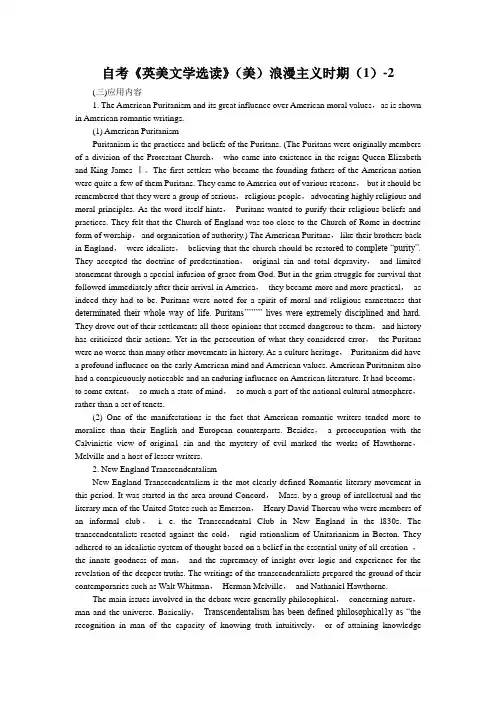
自考《英美文学选读》(美)浪漫主义时期(1)-2(三)应用内容1. The American Puritanism and its great influence over American moral values,as is shown in American romantic writings.(1) American PuritanismPuritanism is the practices and beliefs of the Puritans. (The Puritans were originally members of a division of the Protestant Church,who came into existence in the reigns Queen Elizabeth and King James Ⅰ。
The first settlers who became the founding fathers of the American nation were quite a few of them Puritans. They came to America out of various reasons,but it should be remembered that they were a group of serious,religious people,advocating highly religious and moral principles. As the word itself hints,Puritans wanted to purify their religious beliefs and practices. They felt that the Church of England was too close to the Church of Rome in doctrine form of worship,and organization of authority.) The American Puritans,like their brothers back in England,were idealists,believing that the church should be restor ed to complete “purity”. They accepted the doctrine of predestination,original sin and total depravity,and limited atonement through a special infusion of grace from God. But in the grim struggle for survival that followed immediately after their arrival in America,they became more and more practical,as indeed they had to be. Puritans were noted for a spirit of moral and religious earnestness that determinated their whole way of life. Puritans’’’’’’’’ lives were extremely disciplined and hard. They drove out of their settlements all those opinions that seemed dangerous to them,and history has criticized their actions. Yet in the persecution of what they considered error,the Puritans were no worse than many other movements in history. As a culture heritage,Puritanism did have a profound influence on the early American mind and American values. American Puritanism also had a conspicuously noticeable and an enduring influence on American literature. It had become,to some extent,so much a state of mind,so much a part of the national cultural atmosphere,rather than a set of tenets.(2) One of the manifestations is the fact that American romantic writers tended more to moralize than their English and European counterparts. Besides,a preoccupation with the Calvinistic view of origina1 sin and the mystery of evil marked the works of Hawthorne,Melville and a host of lesser writers.2. New England TranscendentalismNew England Transcendentalism is the mot clearly defined Romantic literary movement in this period. It was started in the area around Concord,Mass. by a group of intellectual and the literary men of the United States such as Emerson,Henry David Thoreau who were members of an informal club,i. e. the Transcendental Club in New England in the l830s. The transcendentalists reacted against the cold,rigid rationalism of Unitarianism in Boston. They adhered to an idealistic system of thought based on a belief in the essential unity of all creation ,the innate goodness of man,and the supremacy of insight over logic and experience for the revelation of the deepest truths. The writings of the transcendentalists prepared the ground of their contemporaries such as Walt Whitman,Herman Melville,and Nathaniel Hawthorne.The main issues involved in the debate were generally philosophical,concerning nature,man and the universe. Basically,Transcendentalism has been defined philosophical1y as “the recognition in man of the capacity of knowing truth intuitively,or of attaining knowledgetranscending the reach of the senses.” Emerson once proclaimed in a speech,“Nothing is at last sacred but the integrity of your own mind.” Other concepts that accompanied Transcendentalism inc1ude the idea that nature is ennobling and the idea that the individual is divine and,therefore,self-re1iant.3. American Romanticists differed in their understanding of human nature.To the transcendentalists such as Emerson and Thoreau,man is divine in nature and therefore forever perfectible; but to Hawthorne and Melville,everybody is potentially a sinner,and great moral courage is therefore indispensab1e for the improvement of human nature,as is shown in Hawthorne’s The Scarlet Letter.。
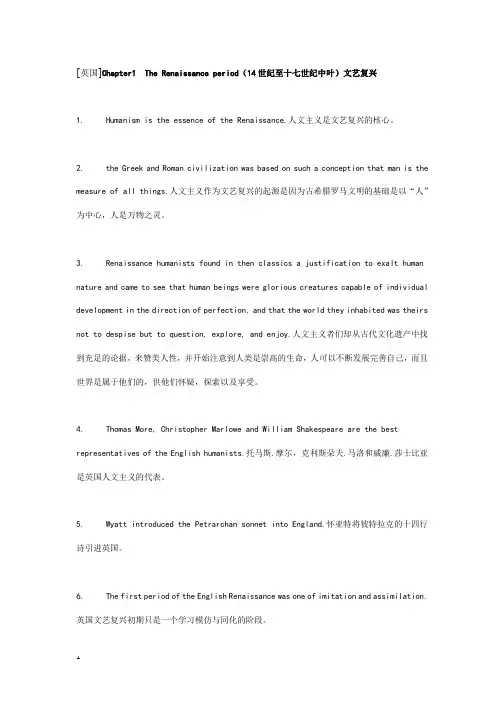
[英国]Chapter1 The Renaissance period(14世纪至十七世纪中叶)文艺复兴1. Humanism is the essence of the Renaissance.人文主义是文艺复兴的核心。
2. the Greek and Roman civilization was based on such a conception that man is the measure of all things.人文主义作为文艺复兴的起源是因为古希腊罗马文明的基础是以“人”为中心,人是万物之灵。
3. Renaissance humanists found in then classics a justification to exalt human nature and came to see that human beings were glorious creatures capable of individual development in the direction of perfection, and that the world they inhabited was theirs not to despise but to question, explore, and enjoy.人文主义者们却从古代文化遗产中找到充足的论据,来赞美人性,并开始注意到人类是崇高的生命,人可以不断发展完善自己,而且世界是属于他们的,供他们怀疑,探索以及享受。
4. Thomas More, Christopher Marlowe and William Shakespeare are the best representatives of the English humanists.托马斯.摩尔,克利斯朵夫.马洛和威廉.莎士比亚是英国人文主义的代表。
5. Wyatt introduced the Petrarchan sonnet into England.怀亚特将彼特拉克的十四行诗引进英国。
英美文学选读Chapter One The Renaissance Period文艺复兴时期埃德蒙·斯宾塞Edmund Spenser 1552-15991、生平出生在伦敦受过良好的教育:泰勒商人学校、剑桥的潘布洛克学校后来,在伊丽莎白女王一世的宠臣莱特伯爵的帮助下,渐渐走上高的地位,获得好的财富在猖狂的爱尔兰民族起义后,被迫离开他的基尔格尔摩城堡因饥饿与贫困,死于威斯敏特的一个酒馆中,被葬于乔叟(其导师)的墓旁2、创作生涯(1)抒情诗(2)传奇史诗《仙后》的构思、情节、内容、主题3、选读《仙后》The Faerie Queen代表作, 传奇史诗The masterpiece①创作意图:通过创作“历史诗”,描绘出一个完美的典型的绅士To present through a “historical poem”, the example of a perfect gentleman,塑造遵守道德规范的绅士或贵族To fashion a gentleman for noble person in virtuous and gentle discipline.②主题:残酷战争与忠贞爱情The theme is Fierce wares and faithful loves(romantic)③线索:亚瑟与仙后格劳安娜Arthur and Gloriana, the Fairy Queen④该诗充满了惊险情节,以及奇异之物:龙、女巫、施了魔法的树、巨人、城堡、以及角斗的骑士。
It?s full of adventures and marvels, dragons, witches, enchanted trees, giants, jousting Knights and castles.⑤也是一篇寓言诗:红十字骑士——神圣的美德,自我节制的美德,英国国教圣公会It?s also an allegory: the Red-Cross Knight represents Holiness, represents Temperance, and symbolizing the Anglican Church.⑥其第一段在很大程度上是该诗的纲领缩影It?s in a way an epitome of the whole poem.4、斯宾塞诗节的构成及特点The main qualities of his poetry完美的韵律、罕见的美感、奇妙的想象、崇高的道德纯洁性与严肃性、一种献身的理想主义Perfect melody, rare sense of beauty, lofty moral purity and seriousness, splendid imagination, dedicated idealism.克里斯朵夫·马洛Christopher Marlowe1、生平与创作生涯出生在坎特伯雷鞋商之家先后靠奖学金在王室学校和剑桥大学读书在剑桥大学期间,创作了《帖木儿》1584年后,深受文艺复兴思潮影响,体现在《浮士德博士的悲剧》具备了放荡不羁的热情和初入知识王国的青年所拥有的自负死于一次在酒店与别人发生口角而引发的械斗中2、著名悲剧(1)《铁木耳大帝》讲述一个普通牧民铁木耳如何登上国王宝座,成为一个野心勃勃、残暴无情的鞑靼统治者的故事。
英美文学选读(1)Selected Readings of British and American Literature (1)一、基本信息课程代码:2020123课程学分: 2面向专业:英语课程性质:专业必修课课程类型:理论教学课开课院系:外国语学院英语系使用教材:主教材:1.《英国文学史及选读》(第1册)(第1版);吴伟仁编,外语教学与研究出版社,2008.2.《英国文学史及选读》(第2册)(第1版);吴伟仁编,外语教学与研究出版社,2008.参考教材:1.《新编英国文学》,罗经国编,外语教学与研究出版社,2010.2.《英国文学简史》,刘炳善,河南人民出版社,2001.先修课程:《基础英语》(1-4)并修课程:《高级英语》(1)后续课程:《英美文学选读》(2)二、课程简介英美文学选读课程主要从英美两国历史、语言、文化发展的角度,介绍英美两国文学各历史阶段的主要背景,文学文化思潮,文学流派,社会政治、经济、文化等对文学发展的影响,主要作家的文学生涯、创作思想、艺术特色及其代表作品的主题结构、人物刻画、语言风格和思想意义等。
本课程旨在培养英语专业学生理解、掌握英美文学的基本理论知识和鉴赏英美文学原著的能力。
英美文学课程的开设有利于提高学生的语言运用能力、提升学生对文学原著鉴赏的水平,培养学生的文学审美意识,使学生在宏观把握文学课程的知识点的同时,增强语言功底,增强对英美文学原著的理解,特别是对作品中表现的社会生活和人物思想感情的理解,增强他们分析作品的艺术特色的能力、掌握正确评价文学作品的标准和方法,对英美两国文学形成与发展的全貌有一个概括的了解,为以后的研究打下坚实基础。
三、选课建议英美文学选读课程是英语专业高年级学生的必修课程,属于提升拔高课程,其前提是学生应具有扎实的语言基本功、一定的文学知识和初步的科学研究方法。
四、课程与培养学生能力的关联性五、课程学习目标通过本课程的学习,学生应知道英美两国文学的形成与发展过程,熟悉部分西方文化,了解西方主要文学流派和主要文学作家,理解文学的本质与基本特征,掌握文学批评的基本知识和方法。
英美文学选读翻译(英语专业自考)第一部分:英国文学第一章文艺复兴时期文艺复兴标志着一个过渡时期,即中世纪的结束和现代社会的开始。
一般来说,文艺复兴时期是从十四世纪到十七世纪中叶。
它从意大利兴起,伴随着绘画、雕塑和文学领域的百花齐放,而后文艺复兴浪潮席卷了整个欧洲。
文艺复兴,顾名思义即重生、复苏,是由一系列历史事件激发推动的,其中包括对古希腊罗马文化的重新发现。
地理天文领域的新发现,宗教改革及经济发展。
因此,文艺复兴从本质上是欧洲人文主义者竭力摒弃中世纪欧洲的封建主义,推行代表新兴城市资产阶级利益的新思想,并恢复早期宗教的纯洁性,远离腐败的罗马天主教廷的一场运动。
文艺复兴浪潮影响到英国的速度比较慢,不仅因为英国远离欧洲大陆,而且还因为其国内的动荡不安。
乔叟去世后的一个半世纪是英国历史上最动荡不安的时期。
好战的贵族篡取了王位,使英国走上自我毁灭之路。
著名的玫瑰之战就是极好的例子。
后来理查三世的恐怖统治标志着内战的结束,在都铎王朝的统治下英国的民族情感又成长起来。
然而直到亨利八世统治期间(1509-1547),文艺复兴的春风才吹入英国。
在亨利八世的鼓励下,牛津的改革派学者和人文主义者们将古典文学引入英国。
基于古典文学作品及《圣经》的教育重获生机,而十五世纪就被广泛传阅的文学作品则更加流行了。
自此,英国的文艺复兴开始了。
英国,尤其是英国文学进入了黄金时代。
这个时期涌现出莎士比亚、斯宾塞、约翰逊、锡德尼、马洛、培根及邓恩等一大批文学巨匠。
但英国的文艺复兴并未使新文学与旧时代彻底决裂,带有十四、十五世纪特点的创作态度与情感依然贯穿在人文主义与改革时代。
人文主义是文艺复兴的核心。
它源于努力恢复中世纪产生的对古希腊罗马文化的尊崇。
人文主义作为文艺复兴的起源是因为古希腊罗马文明的基础是以"人"为中心,人是万物之灵。
通过这些对古代文化崭新的研究,人文主义者不仅看到了光彩夺目的艺术启明星,还在那古典作品中寻求到了人的价值。
自考英美文学选读第一章浪漫主义时期(美国)(课文翻译)英美文学选读翻译(英语专业自考)第二部分:美国文学第一章浪漫主义时期浪漫主义时期开始于十八世纪末,到内战爆发为止,是美国文学史上最重要的时期。
华盛顿·欧文出版的《见闻札记》标志着美国文学的开端,惠特曼的《草叶集》是浪漫主义时期文学的压卷之作。
浪漫主义时期的文学是美国文学的繁荣时期,所以也称为"美国的文艺复兴。
"美国社会的发展哺育了"一个伟大民族的文学"。
年轻的美国没有历史的沉重包袱,很快在政治、经济和文化方面成长为一个独立的国家。
这一时期也是美国历史上西部扩张时期,到1860年领土已开拓到太平洋西岸。
到十九世纪中叶,美国已由原来的十三个州扩大到二十一个州,人口从1790年的四百万增至1860年的三千万。
在经济上,年轻的美国经历向工业的转化,影响所及不仅仅是城市,而且也包括农村。
蒸汽动力在工、农业生产上的运用、工厂的建立、劳动力的大量需求以及科技上的发明创造使经济生活得到了重组。
另外,大量移民促进了工业更加蓬勃的发展。
政治上,民主与平等成为这个年轻国家的理想,产生了两党制。
值得一提的是这个国家的文学和文化生活。
随着独立的美国政府的成立,美国人民已感到需要有美国文学,表达美国人民所特有的经历:早期清教徒的殖民,与印第安人的遭遇,边疆开发者的生活以及西部荒原等。
这个年轻国家的文学富有想象,已产生了一种文学环境。
报刊杂志如雨后春笋,出现了一大批文学读者,形成了十九世纪上半叶蓬勃的浪漫主义的文学思潮。
外国的,尤其是英国的文学大师对美国作家产生了重大影响。
美国作家由于秉承了与英国一样的文化传统,形成了同英国一样的浪漫主义风格。
欧文(Irving)、库柏(Cooper),坡(Poe),弗伦诺(Freneau)和布雷恩特(Bryant)一一反古典主义时期的文学样式和文学思潮,开创了较新的小说和诗歌形式。
这一时期大多数美国文学作品中,普遍强调文学的想象力和情感因素,注重生动的描写、异国情调的表达、感官的体会和对超自然力的描述。
英美文学选读(1)
Selected Readings of British and American Literature (1)
一、基本信息
课程代码:2020123
课程学分: 2
面向专业:英语
课程性质:专业必修课
课程类型:理论教学课
开课院系:外国语学院英语系
使用教材:主教材:1.《英国文学史及选读》(第1册)(第1版);吴伟仁编,外语教
学与研究出版社,2008.
2.《英国文学史及选读》(第2册)(第1版);吴伟仁编,外语教
学与研究出版社,2008.
参考教材:1.《新编英国文学》,罗经国编,外语教学与研究出版社,2010.
2.《英国文学简史》,河南人民出版社,2001.
先修课程:《基础英语》(1-4)
并修课程:《高级英语》(1)
后续课程:《英美文学选读》(2)
二、课程简介
英美文学选读课程主要从英美两国历史、语言、文化发展的角度,介绍英美两国文学各历史阶段的主要背景,文学文化思潮,文学流派,社会政治、经济、文化等对文学发展的影响,主要作家的文学生涯、创作思想、艺术特色及其代表作品的主题结构、人物刻画、语言风格和思想意义等。
本课程旨在培养英语专业学生理解、掌握英美文学的基本理论知识和鉴赏英美文学原著的能力。
英美文学课程的开设有利于提高学生的语言运用能力、提升学生对文学原著鉴赏的水平,培养学生的文学审美意识,使学生在宏观把握文学课程的知识点的同时,增强语言功底,增强对英美文学原著的理解,特别是对作品中表现的社会生活和人物思想感情的理解,增强他们分析作品的艺术特色的能力、掌握正确评价文学作品的标准和方法,对英美两国文学形成与发展的全貌有一个概括的了解,为以后的研究打下坚实基础。
三、选课建议
英美文学选读课程是英语专业高年级学生的必修课程,属于提升拔高课程,其前提是学生应具有扎实的语言基本功、一定的文学知识和初步的科学研究方法。
四、课程基本要求
通过本课程的学习,学生应知道英美两国文学的形成与发展过程,熟悉部分西方文化,了解西方主要文学流派和主要文学作家,理解文学的本质与基本特征,掌握文学批评的基本知识和方法。
在此基础上引导学生学习英美文学作品,包括诗歌、戏剧、小说、散文等,理解主要作家代表作品内容和精神。
通过学习原文文学作品,培养学生阅读、欣赏、理解能力,帮助学生在掌握
文学知识的同时提高他们的文学欣赏及独立研究的能力。
五、课程内容
第1章了解盎格鲁·撒克逊和盎格鲁·诺曼时期的文学;
理解文学术语“epic”;
解读英语史诗“Beowulf”;
分析“Beowulf”的题材与主题;
教学难点:“Beowulf”的文学意义。
第2章了解杰弗里·乔叟及其代表作“The Canterbury Tales”;
理解文学术语“alliteration头韵法”;
解读“The Canterbury Tales”的总序;
分析“The Canterbury Tales”的文学特色
教学难点:The Canterbury Tales的社会意义。
第3章了解英国文艺复兴;
知道威廉·莎士比亚及其主要作品;
理解文学术语“Renaissance”和“Humanism”;
解读莎士比亚的第十八首十四行诗;
教学难点:“Hamlet”中独白“To Be or Not to Be”的主题分析。
第4章理解弗朗西斯·培根及其主要作品;
解读培根“Of Studies”;
教学难点:培根的创作主题分析。
第5章理解玄学派诗人;
知道约翰·邓恩及其作品;
解读约翰·邓恩的“Death Be Not Proud”和“A Valediction: Forbidding Mourning”;
教学难点:“A Valediction: Forbidding Mourning”的主题分析。
第6章了解熟悉丹尼尔·笛福及其主要作品;
解读“Robinson Crusoe (Crusoe Saves Friday from the Cannibals)”;
教学难点:“Robinson Crusoe”主题分析。
第7章理解文学术语“Neo-Classicism”;
知道乔纳森·斯威夫特及其主要作品;
解读“Gulliver's Travels (A V oyage to Lilliput)”;
教学难点:“Gulliver's Travels”的主题分析。
第8章了解熟悉威廉·布莱克、罗伯特·彭斯及其主要作品;
解读布莱克的“London”;
赏析罗伯特·彭斯的代表作“A Red, Red Rose”;
教学难点:“London” 的主题分析。
第9章了解熟悉威廉·华兹华斯及其主要诗作;
理解“Lake Poets”;
解读“I Wandered Lonely as a Cloud”和“The Solitary Reaper”;
教学难点:“The Solitary Reaper”的主题分析。
第10章理解玄学派诗人;
熟悉约翰·邓恩及其作品;
解读约翰·邓恩的“Death Be Not Proud”和“A Valediction: Forbidding Mourning”;
教学难点:“A Valediction: Forbidding Mourning”的主题分析。
第11章了解熟悉波西·比希·雪莱、约翰·济慈及其主要作品;
解读“To a Sky-Lark”和“Ode to a Nightingale”;
教学难点:“To a Sky-Lark” 的主题分析。
第12章了解熟悉简·奥斯丁及其主要作品;
理解简·奥斯丁小说的主要特色;
解读“Pride and Prejudice (Chapter I)”;
教学难点:“Pride and Prejudice”的主题分析。
第13章了解查尔斯·狄更斯及其主要作品;
熟悉“Oliver Twist”的故事梗概及其特点;
理解文学术语“Realism”;
解读“Oliver Twist (II and III)”;
教学难点:“Oliver Twist”的主题分析。
第14章了解勃朗特姐妹及其主要作品;
熟悉“Wuthering Heights”;
理解“Wuthering Heights”的主要特点;
解读“Wuthering Heights (XV)”;
教学难点:“Wuthering Heights”的主题分析。
第15章了解熟悉托马斯·哈代及其主要作品;
理解托马斯·哈代小说的主要特点;
解读“Tess of the D' Urberoilles (XIV and XXXV)”;
教学难点:“Tess of the D' Urberoilles”的主题分析。
六、课内训练基本要求
有条不紊、深入浅出地讲解文学理论知识和作品欣赏,在此过程中提出启发性问题让学生思考,引导学生用一定的文学理论知识去提高对作品的赏析,最终提升学生的审美情趣。
七、教学进度
英国文学部分
八、考核方式和成绩评定
考核方式:考试课(闭卷)
成绩评定:平时成绩占50%(包括作业15%、课堂表现15%、背诵15%、出勤率5%);期末考试占50%。
撰写:杨大亮系主任:吴远恒教学院长:孙文抗。